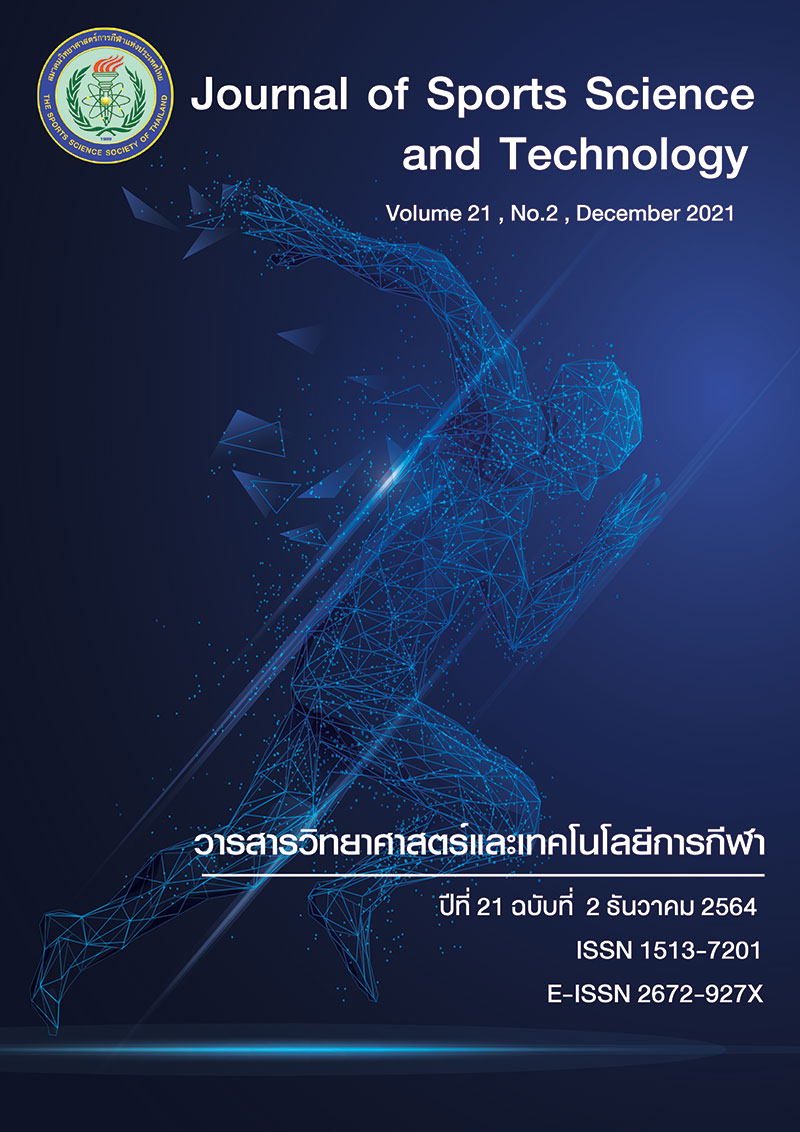PERCEPTION OF SPORTS TRAINING FACILITIES EFFICIENCY AND GUIDELINE FOR DEVELOPING NATIONAL SPORTS TRAINING CENTER OF SPORTS AUTHORITY OF THAILAND
DOI:
https://doi.org/10.14456/jsst.2021.16Keywords:
National sports training center, Sports facility, Capacity developmentAbstract
This research article aimed to examine the efficiency of sport training facilities according to the Sport
Policy factors Leading to International Sporting Success (SPLISS) and investigated a potential development of
regional sport training center leveraging to national sports training center. Mix method research design was
employed. Three regional sport training centers: national training center Mauklek, Saraburi province; national
training center; national training center His Majesty the King's 80th Birthday Anniversary Stadium 5th December
2007, Nakhon Ratchasima province; and national training center 700th Anniversary Chiang Mai Celebrate
Stadium were chosen. Quantitative research sample was 693 service providers and users. Qualitative research
sample was 20 informants who qualified 3 inclusion criteria. The instruments are questionnaire developed by
researchers with the validity and reliability values at 0.95 and 0.94 respectively. Focus group questions also
operated. Small group interview data was collected by the assistant researchers and electronic meeting data
was done via Zoom program. Statistics used were Chi-square, analysis of variance, confirmatory factor analysis,
data triangulation analysis. Mix method approach was used to concluded the results.
The research results were found that the 3 national training centers has average perception of
efficiency of sport training facilities at high level and; the potential development of regional sport training center
leveraging to national sports training center is consistent with empirical data and appropriate for application.
Managing the 3 national training centers should prioritize by Need data, High-quality facilities network,
Travelling data, Accessibility, Renovation fund, Time spend of travelling, High-quality facilities, Infrastructure
data, and Facilities data. Research recommendation has 3 dimensions for operationalization in current situation.
(Journal of Sports Science and Technology 2021; 21 (2):125-140)
(Received: 4 August 2021 , Revised: 28 October 2021, Accepted: 9 November 2021)
KEYWORDS: Sports facility / National sports training center / Capacity development
*Corresponding author: Dittachai CHANKUNA
Faculty of Liberal Arts, Thailand National Sports University Chon Buri Campus,
Chon Buri, THAILAND, 20000
E-mail: c.dittachai@tnsu.ac.th
References
2. De Bosscher V, Shibli S, Westerbeek H, van Bottenburg M. (2015). Successful elite sport policies. An international comparison of the Sports Policy factors Leading to International Sporting Success (SPLISS 2.0) in 15 nations. Aachen: Meyer & Meyer.
3. Tasnaina N, Tasnaina O. Guidelines for promoting sports from basic sports to professional sports for Thailand. Journal of Health, Physical Education and Recreation, 2022; 48(1): 154-165.
4. Sports Authority of Thailand. Annual report 2563 Sports Authority of Thailand Ministry of Tourism and Sports. Bangkok: Sports Authority of Thailand; 2020.
5. Udomkitpanya C, Wiruchnipawan W. Promoting administration of modern technology application for competition of the Sport Authority of Thailand according to the Sufficiency Economy philosophy. EAU Heritage Journal Social Science and Humanity, 2017; 7(2): 157-164.
6. Puapuang K, Kanchanapokin K. The management of Rajamangala national stadium, Sport Authority of Thailand for service quality. Journal of Multidisciplinary in Humanities and Social Sciences, 2020; 3(1): 51-62.
7. Chaiyrak P, Chobthamasakul C, Hengsawat R, Somkane W. Exercising behaviors of user of the Sports Authority of Thailand. Journal of Health, Physical Education and Recreation, 2021; 47(2): 207-217.
8. Turner AN, Bishop C, Cree J, Carr P, McCann A, Bartholomew B, Halsted L. Building a high-performance model for sport: a human development-centred approach. Strength and Conditioning Journal, 2019; 41(2): 100-107. doi: 10.1519/SSC.0000000000000447
9. Gullich A, Emrich E. Individualistic and collective approach in athlete support programs in the German high-performance sport system. European Journal for Sport and Society, 2012; 9(4): 243-268. doi: 10.1080/16138171.2012.11687900
10. Rynne SB, Mallett C, Tinning R. High performance sport coaching: institute of sport as sites for learning. International Journal of Sports Science & Coaching, 2006; 1(3): 223-234. doi: 10.1260/174795406778604582
11. Japanese Olympic Committee [Internet]. Tokyo: Ajinomoto national training center [updated 2021 July 24; cited 2021 Jul 24]. Available from https://www.joc.or.jp/english/ntc/
12. Hu LT, Bentler PM. Cutoff criteria for fit indices in covariance structure analysis: conventional criteria versus new alternatives. Structural Equation Modeling: A Multidisciplinary Journal. 1999; 6(1): 1-55.
13. Strauss A, Corbin J. Basics of qualitative research: grounded theory procedures and techniques. 1990. Newbury Park, CA : Sage.
14. Balyi I, Way R., Higgs C. Long-Term Athlete Development. 2013. Champaign, Illinois : Human Kinetics.
15. Chankuna D, Khositdham P. Social benefits model of sports city in Chon Buri. Journal of Faculty of Physical Education, 2020; 23(2): 14-24.
16. Hongchumpear P, Sripokangkul S. Study on potentiality in Khon Kaen development toward the sport city. Journal of Local Governance and Innovation, 2020; 4(1): 15-30.
17. Pearson D. Managing sport facilities and major events. Journal of Sport Management, 2006; 20(3): 435-436. doi: 10.1123/jsm.20.3.435






